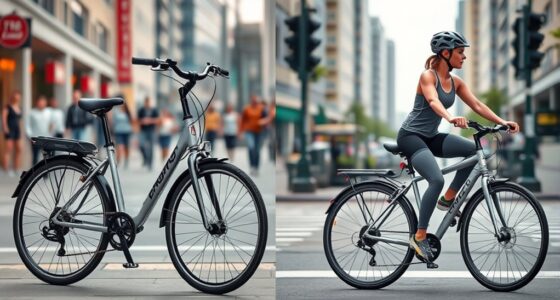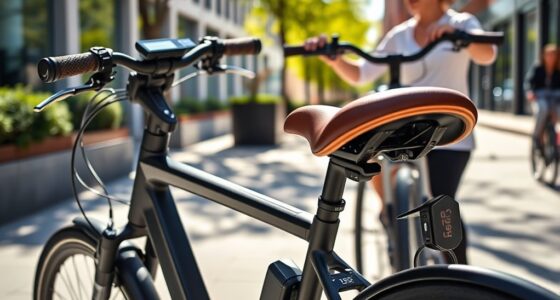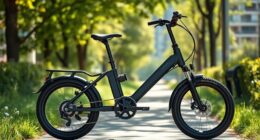Pedal assist systems use sensors and sophisticated algorithms to monitor your pedaling effort and cadence, automatically adjusting motor support to make your ride smoother and more efficient. This synergy between sensors, torque, and battery efficiency helps extend your bike’s range and reduces energy consumption, making commutes less tiring. By optimizing power delivery based on terrain and effort, pedal assist improves comfort and sustainability. Keep exploring how this technology is transforming your daily rides.
Key Takeaways
- Pedal assist uses sensors to detect rider effort and adjust motor support for smoother, more efficient riding.
- The system optimizes motor torque based on terrain and pedaling cadence, reducing rider fatigue.
- Efficient coordination between battery and motor extends ride range and conserves energy for longer commutes.
- Advanced algorithms enable real-time adjustments, ensuring consistent assistance and improving ride comfort.
- Enhanced pedal assist technology promotes sustainable commuting by reducing energy consumption and mechanical wear.

Have you ever wondered how pedal assist systems in e-bikes work? It’s a mix of advanced technology designed to make your ride smoother and more efficient. At the core, these systems rely heavily on understanding how battery efficiency and motor torque interact. When you pedal, sensors detect your effort and communicate with the motor, which then provides just the right amount of assistance. This balance optimizes battery life, allowing you to go farther on a single charge. If the system isn’t efficient, the battery drains faster, limiting your range and making your commute less practical. That’s why manufacturers focus on improving battery efficiency — to give you more power for longer trips without constantly recharging.
Understanding pedal assist: sensors, torque, and battery efficiency work together for a smoother, longer ride.
Motor torque plays a pivotal role here. It’s the force the motor produces to help turn the wheels, directly impacting how much assistance you get. When you pedal harder, the system responds by increasing motor torque, making your effort feel lighter. Conversely, if you’re easing up, the motor reduces torque, conserving energy. This dynamic adjustment isn’t just about comfort; it’s about efficiency. High motor torque at the right moments means you’re not wasting power when you don’t need it. Instead, the system intelligently ramps up assistance during steep climbs or headwinds, and scales back on flat terrain or downhill sections. This intelligent modulation ensures your battery isn’t drained unnecessarily, extending your range and making your commute more predictable.
Understanding how these components work together can help you appreciate the science behind pedal assist. Modern e-bikes use sophisticated algorithms to analyze your pedaling cadence, force, and even road conditions. They constantly tweak motor torque to match your effort, ensuring seamless support. Additionally, advancements in battery technology continue to enhance overall efficiency, allowing for longer rides and better performance. The more efficient this process, the less energy your battery consumes for each mile traveled. As a commuter, this means fewer stops for recharging and more reliable performance, especially when you’re pressed for time or _orchestrating_ busy streets. Plus, smarter management of motor torque not only conserves energy but also reduces wear and tear on mechanical parts, prolonging the life of your bike.
In essence, the synergy between battery efficiency and motor torque in pedal assist systems is what makes e-bikes such an effective commuting option. It’s a science finely tuned to help you pedal smarter, not harder, while maximizing your battery’s potential. When you understand how these elements work together, you can better appreciate the engineering that gets you where you need to go with less effort and more reliability. That’s the real power of pedal assist technology — it’s designed to support your ride, making your commute easier, more sustainable, and more enjoyable.
Frequently Asked Questions
How Does Pedal Assist Impact Battery Life Over Time?
You might wonder how pedal assist affects your e-bike’s battery life over time. Using pedal assist can help with power management, reducing strain on your battery during rides. However, frequent use and high levels of assistance accelerate battery degradation. To prolong your battery’s lifespan, avoid overusing max assist levels and keep your battery charged between 20-80%. Proper maintenance guarantees your battery stays healthy longer, saving you money and hassle later.
Can Pedal Assist Systems Be Customized for Different Riding Styles?
Yes, pedal assist systems can be customized to match your riding preferences. You can adjust motor customization settings to increase or decrease assistance levels, ensuring a tailored experience whether you prefer a gentle boost or more power. Many e-bikes allow you to fine-tune the pedal assist to suit your riding style, making your commute more comfortable and efficient while aligning the motor’s performance with your personal needs.
What Safety Features Are Integrated With Pedal Assist Technology?
Think of pedal assist technology as your bike’s safety guardian. It integrates sensors that detect your pedaling and braking, ensuring smooth power delivery. Emergency protocols kick in if sensors detect sudden stops or irregular movements, automatically slowing the bike to prevent accidents. These safety features keep you secure, letting you focus on the road ahead. With sensor integration and emergency protocols, pedal assist becomes not just smart, but also a reliable partner on your commute.
How Does Pedal Assist Perform in Extreme Weather Conditions?
In extreme weather, pedal assist can still perform well if your e-bike has weather resilience features like waterproof components and traction control. Traction control helps maintain grip on slippery surfaces, ensuring safe riding. Weather-resistant design prevents water damage and maintains system reliability. While snow or rain can challenge any bike, pedal assist with these features offers better control and confidence, making your commute safer and smoother despite harsh conditions.
Are There Health Benefits or Drawbacks to Using Pedal Assist Regularly?
Using pedal assist regularly offers notable cardiovascular benefits, helping you improve heart health with less strain. It also promotes muscle engagement, especially in your legs, without overexerting yourself. However, relying too much on assist might lead to reduced muscle strength over time. To maximize health benefits, vary your rides and include some manual pedaling, ensuring you stay active and engaged while enjoying the convenience of pedal assist.
Conclusion
Understanding the science behind pedal assist is like revealing a secret recipe that makes your commute smoother and more enjoyable. By harnessing motor power, you’re effectively turning your bike into a hybrid of human effort and technology—like a dance partner perfectly in sync. So, next time you pedal, remember you’re riding a smart, efficient machine designed to make your journey easier and greener. Embrace it, and let science lead the way to better, more confident commuting.









